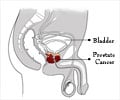Researchers discover that there may be warning signs to help surgeons avoid damaging part of the urinary system during robot-assisted surgical removal of prostate cancer.

Under guidance of Drs. Mani Menon and James Peabody, a research team at Henry Ford's Vattikuti Urology Institute focused on 6,442 consecutive patients who underwent robotic prostatectomy by one of five surgeons at the hospital from January 2001 to June 2013. "We found three patients in the study group, operated on by two of the five surgeons, who sustained complete transection of the ureter, although these surgeons were highly experienced, having performed more than 1,000 robotic prostatectomies," says Jay Jhaveri, M.D., M.P.H., lead author of the study. "This is well beyond the accepted learning curve of 100 cases."
"One of the patients required readmission for further treatment, and we were able to identify risk factors that predisposed all of them to ureteral injury." Among them were a history of infection, abdominal surgery, radiation treatment, enlarged prostate glands and prior transurethral resection of the prostate, in which prostate tissue is surgically trimmed to remove urine flow blockage. "This knowledge can help identify future patients who are at high risk of sustaining ureteral injury during robotic removal of a cancerous prostate gland," Dr. Jhaveri says.
"Measures can then be taken either before or during surgery to reduce the probability of such injury."The study concluded that despite its relatively rare occurrence, previous studies have isolated trends for patients who are at high risk for ureteral injury during prostatectomy. All of the Henry Ford patients had previous abdominal surgery and none of their injuries were noted intraoperatively."We found a 0.046% rate of ureteral injury during robotic prostatectomy which compares favorably with other similar studies and published data for this topic," Dr. Jhaveri says.Besides the clear benefits to the patients, the study shows such preventive measures can also help avoid prolonged, expensive hospitalization, need for additional treatment or surgery, as well as the costs of follow-up treatments.
Source-Eurekalert

![Prostate Specific Antigen [PSA] & Prostate Cancer Diagnosis Prostate Specific Antigen [PSA] & Prostate Cancer Diagnosis](https://images.medindia.net/patientinfo/120_100/prostate-specific-antigen.jpg)







